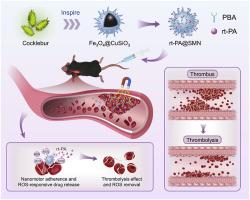Cocklebur-inspired magnetic nanomotors for targeted thrombus therapy
IF 18
1区 医学
Q1 ENGINEERING, BIOMEDICAL
引用次数: 0
Abstract
Nanomotors have come to the forefront as a powerful tool for thrombolysis. Attempts in this field tend to improve the structure and function of nanomotors for safe and efficient treatment. To address the problem of low utilization and high bleeding risk, herein, we present a magnetically-driven cocklebur-like nanomotor for efficient delivery of recombinant tissue plasminogen activator (rt-PA) to treat thrombus. Composed of Fe3O4 cores and spiked silicate shells, these nanomotors can rapidly respond to magnetic fields and adhere to the thrombus regardless of the blood flow impact. Besides, we use an H2O2-responsive ester to conjugate rt-PA to the nanomotors, releasing the medication only around the thrombus with abundant reactive oxygen species, thereby ensuring effective potency preservation. In vivo study proves that these cocklebur-like nanomotors can successfully treat a mouse model with a reduced thrombus area of 3.3-fold compared with direct-injection of rt-PA. Also, the coagulation system exhibits no obvious changes. All the results confirm the synergistic effect of magnetic control, adherence, and targeted drug release. These features suggest that the efficient thrombolysis ability of these nanomotors could offer new therapeutic strategies and practical value for cardiac, cerebral, and peripheral thrombotic diseases.

针对血栓治疗的cockleber启发的磁性纳米马达
纳米马达作为一种强有力的溶栓工具已经走到了最前沿。在这一领域的尝试倾向于改进纳米马达的结构和功能,以实现安全有效的治疗。为了解决低利用率和高出血风险的问题,在此,我们提出了一种磁驱动的cockleber样纳米马达,用于有效递送重组组织型纤溶酶原激活剂(rt-PA)来治疗血栓。这些纳米马达由Fe3O4核心和尖刺硅酸盐外壳组成,可以快速响应磁场并粘附在血栓上,而不受血流影响。此外,我们使用h2o2反应酯将rt-PA与纳米马达偶联,使药物仅在血栓周围释放,具有丰富的活性氧,从而确保有效的药效保存。体内实验证明,与直接注射rt-PA相比,这些鸟蛤状纳米马达可以成功治疗小鼠模型,使血栓面积减少3.3倍。同时,凝血系统无明显变化。所有结果都证实了磁控、粘附和靶向药物释放的协同作用。这些特点表明,这些纳米马达的高效溶栓能力可以为心脏、大脑和周围血栓性疾病提供新的治疗策略和实用价值。
本文章由计算机程序翻译,如有差异,请以英文原文为准。
求助全文
约1分钟内获得全文
求助全文
来源期刊

Bioactive Materials
Biochemistry, Genetics and Molecular Biology-Biotechnology
CiteScore
28.00
自引率
6.30%
发文量
436
审稿时长
20 days
期刊介绍:
Bioactive Materials is a peer-reviewed research publication that focuses on advancements in bioactive materials. The journal accepts research papers, reviews, and rapid communications in the field of next-generation biomaterials that interact with cells, tissues, and organs in various living organisms.
The primary goal of Bioactive Materials is to promote the science and engineering of biomaterials that exhibit adaptiveness to the biological environment. These materials are specifically designed to stimulate or direct appropriate cell and tissue responses or regulate interactions with microorganisms.
The journal covers a wide range of bioactive materials, including those that are engineered or designed in terms of their physical form (e.g. particulate, fiber), topology (e.g. porosity, surface roughness), or dimensions (ranging from macro to nano-scales). Contributions are sought from the following categories of bioactive materials:
Bioactive metals and alloys
Bioactive inorganics: ceramics, glasses, and carbon-based materials
Bioactive polymers and gels
Bioactive materials derived from natural sources
Bioactive composites
These materials find applications in human and veterinary medicine, such as implants, tissue engineering scaffolds, cell/drug/gene carriers, as well as imaging and sensing devices.
 求助内容:
求助内容: 应助结果提醒方式:
应助结果提醒方式:


